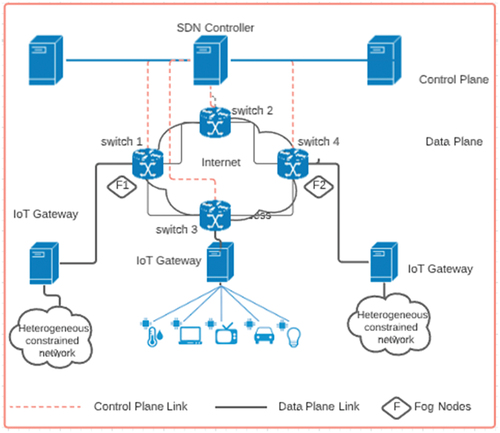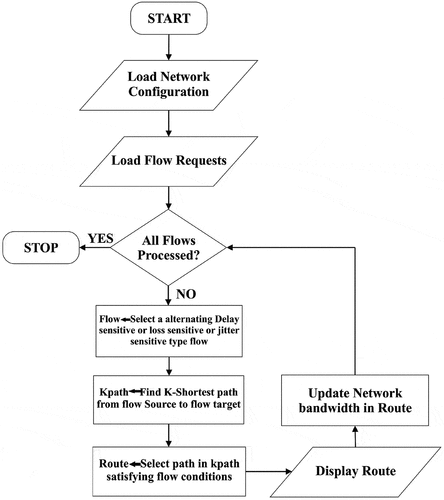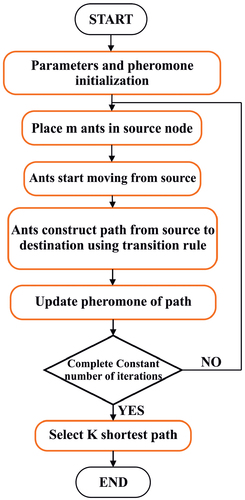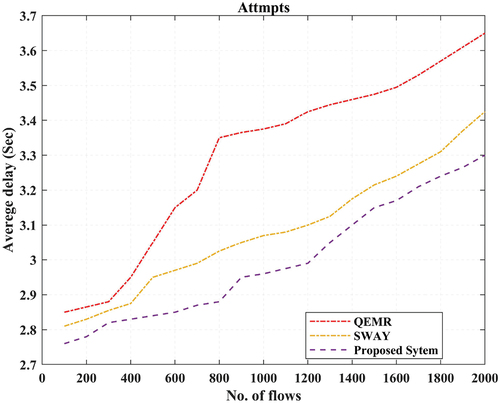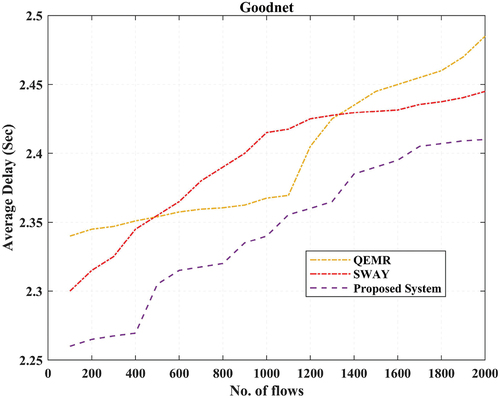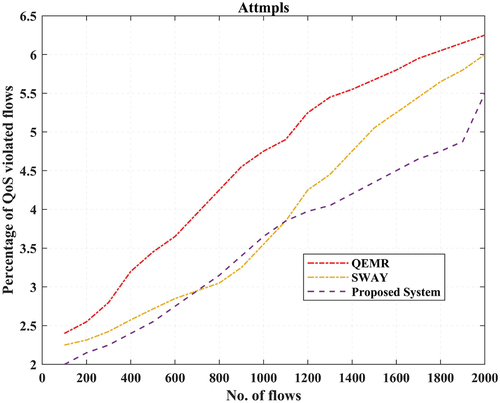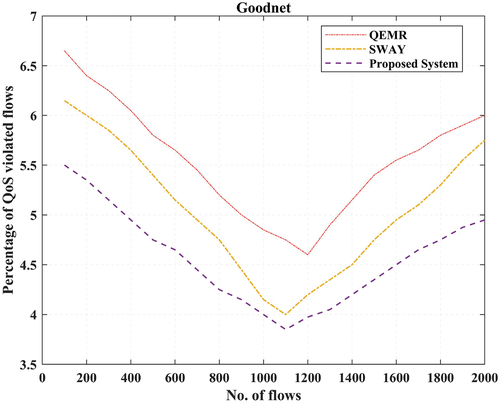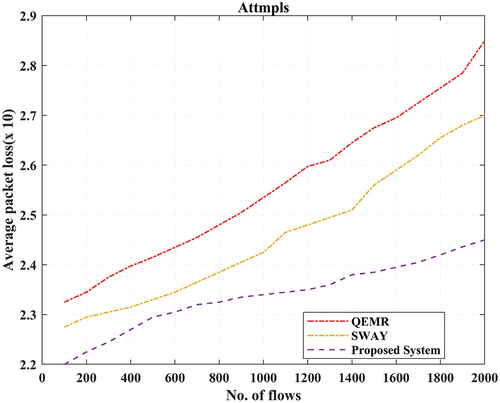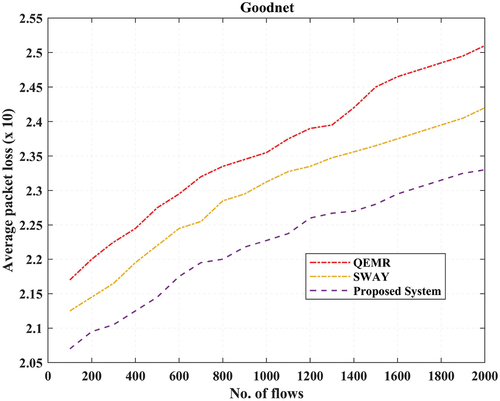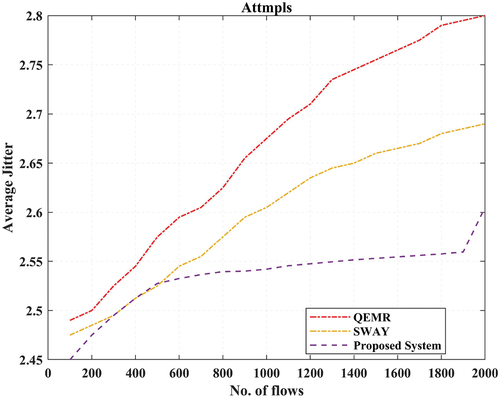 ?Mathematical formulae have been encoded as MathML and are displayed in this HTML version using MathJax in order to improve their display. Uncheck the box to turn MathJax off. This feature requires Javascript. Click on a formula to zoom.
?Mathematical formulae have been encoded as MathML and are displayed in this HTML version using MathJax in order to improve their display. Uncheck the box to turn MathJax off. This feature requires Javascript. Click on a formula to zoom.ABSTRACT
The rising number of Internet of Things (IoT) devices, powered by inexpensive sensors and rapid wireless connections, places challenge on existing internet infrastructure and concerns sustainability issues. For networks to satisfy Quality-of-Service (QoS) standards in the Software-Defined IoT (SDIoT) network, efficient algorithms for routing are required. In SDIoT framework, this research proposes to develop a traffic-aware QoS routing algorithm dependent on ant behavior. In order to enhance QoS routing metrics, this work proposes an Ant Colony Optimization (ACO) based algorithm that focuses IoT device flows that are jitter, delay, and loss-sensitive. The proposed approach optimizes overall network performance with utilizing the fewest resources possible by optimizing the routing path to meet application-specific QoS standards using Yen’s k shortest path algorithm. The suggested approach outperforms current techniques in terms of fulfilling all three types of flows, resulting in sustained network performance enhancements of 5.25% in average delay, 5.15% in QoS-violated flows with Ant-inspired routing, 7% in average packet loss, and 4.65% in average jitter. This research provides an efficient practical way to deal with the growing challenges that IoT applications are posing for network sustainability.
Introduction
The IoT has witnessed remarkable growth, connecting diverse smart objects over the internet, including (Radio Frequency Identifier) RFID tags, wireless actuators, sensors, embedded computers & Machine-to-Machine (M2M) communication devices. This proliferation, driven by applications in smart healthcare, homes, cities, and vehicular automation, has led to increased utilization of natural resources, challenging the sustainable development paradigm (Ja’afreh et al. Citation2022; Udayaprasad et al. Citation2024). Sustainability concerns encompass issues such as high power consumption, resource utilization, and network performance. High-speed wireless connectivity is integral for IoT devices, offering faster data transfer, reduced latency, and efficient support for high-resolution data streams. This advancement ensures optimal responsiveness, scalability for a growing device ecosystem, and energy efficiency, crucial for resource-constrained devices. It also facilitates emerging applications like augmented reality and virtual reality, enriching the IoT experience (Anitha, Vimala, and Shreyas Citation2023).
Routing is a pivotal element in network functionality, particularly in the IoT context where billions of embedded devices continually join the network. The existing best-effort transmission mechanisms are insufficient to guarantee future QoS requirements for various IoT applications. For instance, surveillance applications demand low delay but can tolerate some packet loss, impacting video quality. Given the resource constraints of many IoT devices, including limitations in memory and power, minimizing packet loss is imperative. Therefore, an optimized routing technique is essential to satisfy the evolving QoS demands of IoT applications (Babiker Mohamed et al. Citation2022; Shreyas et al. Citation2020).
The burgeoning growth of IoT devices strains internet infrastructure, intensifying resource utilization, energy consumption, and environmental impact. This computational burden challenges the sustainable development of IoT technologies, requiring continual investments and posing economic complexities. Additionally, the strain may create digital divides, accentuating social disparities in accessing IoT services. Addressing these computational challenges is crucial for ensuring the holistic sustainability of IoT ecosystems within the broader internet framework. The Software-Defined Networking (SDN) approach, with its centralized controller, abstracts control logic from network devices, simplifying management and improving QoS by reducing traffic interference. Despite its advantages, existing approaches have limitations, often neglecting the dynamic aspect of IoT settings, failing to consider content popularity dynamics, and facing scalability challenges. This work addresses these gaps by proposing an ant-inspired traffic-aware QoS routing scheme in the SDIoT network (Bhayo, Hameed, and Shah Citation2020; Shreyas et al. Citation2022).
There are significant limitations to the existing approach that must be taken into consideration. First of all, understanding that IoT deployments constantly shift, it mostly avoids the dynamic aspect of IoT settings to the benefit of static IoT device scenarios. In addition, the scheme’s optimization technique fails to consider into consideration the dynamics of material popularity, that is an essential factor in dynamical IoT environments where content popularity may have an enormous effect on network performance. Moreover, even if the proposed SoftCaching system performed exceedingly well in a number of standards, scalability remains an issue that requires further investigation. The study addresses the need of solving the difficulties connected with controller design, switching design, caching approaches, and security, while also recognizing a need for further studies for enhancing caching and routing within mobile IoT contexts. These limitations collectively underscore the scope for advancements in the existing scheme to better align with the diverse and dynamic nature of IoT environments. The selection of a single or different QoS metrics with linear combination which has failed to satisfy discrete QoS requirements. Rule capacity constraint is not taken into account. Recent developments on SDN in QoS routing management have utilized the flow-based SDN nature to fulfill the QoS requirements like loss-sensitive () and delay-sensitive (
) for ingress traffic from end-to-end devices within the network (Saha, Bera, and Misra Citation2018).
Jitter, the inter-arrival time between packets, significantly influences the quality of services at the receiver. This work uniquely considers jitter-sensitive flows, in addition to delay and loss-sensitive flows, in IoT networks. Leveraging SDN’s procedural nature, it employs Yen’s K shortest path algorithm, integrated with Ant Colony Optimization and QoS-based path selection, to determine optimal forwarding paths tailored to specific implementation requirements. Furthermore, this work accounts for the SDN rule impact the QoS routing capacity, enhancing the understanding of network dynamics. The Ant Colony Optimization technique (Pei, Wang, and Zhang Citation2012), inspired by the cooperative ants behavior, is implemented to identify the shortest path, contributing an innovative dimension to the proposed approach.
Contribution
The contributions of the work include:
(1) A Software-Defined Internet of Things (SDIoT) networks architecture with a centralized controller is proposed to manage network devices at a single point.
(2) A traffic-aware QoS routing method is proposed by splitting the flows into delay, packet loss, and jitter sensitive.
(3) The proposed work integrates the ACO algorithm to get the QoS based routing path.
(4) In the proposed work, rule capacity constraint and hop count are considered to reduce the power consumption to ensure sustainability.
(5) The proposed work performance is evaluated by comparing it with the conventional methods in MATLAB.
Scope of the Work
• The proposed work focuses on the application of a novel routing paradigm for SDIoT networks.
• The specific focus is on formulating a routing scheme that minimizes delay, packet loss, and jitter while fulfilling application-dependent Quality of Service (QoS) requirements for each flow.
• The work aims to deploy a topology with higher diversity of communication links in IoT networks using MATLAB integrated development environment.
• Priorities are assigned to delay, jitter, and loss-sensitive flows based on their requirements, allowing for efficient resource allocation and improved network performance.
• The proposed scheme is designed to satisfy all three types of flows and reduce the QoS violations counts, adaptive for a wide range of IoT applications.
• The simulation of the proposed solution in MATLAB demonstrates its effectiveness in reducing end-to-end delay and the violating QoS percentage flows constraints.
The paper remains organized as a path. Section II paper in concise analyzes literature associated to this research issue later Section III describes the problem concentrated in in this paper. The technique details for the proposed SDIoT based Traffic Aware QoS Routing using an Ant inspired algorithm is displayed in Section IV and the implementation phases also being introduced in section V. In Section VI, the gained experimental setup and validation are inspected. Finally, Section VII gives a paper conclusion and future scope.
Literature Survey
This research (Srinivasulu, Shivamurthy, and Venkataramana Citation2023) focuses on enhancing the resilience of the IoT by addressing routing, energy optimization, and related challenges to extend network lifetime. The proposed methodology introduces an IoT hybrid optimization algorithm-based QoS-aware energy-efficient multipath routing (QEMR) protocol. This approach incorporates a modified teaching-learning-based optimization (MTLO) for clustering, a nonlinear regression-based pigeon optimization (NR-PO) for cluster head determination, and the Deep Kronecker Neural Network (DKNN) for routing and path optimization. Evaluation using the NS-3 simulation tool demonstrates the efficacy of the QEMR scheme. Notably, it achieves substantial energy savings, surpassing existing techniques with an 86.29% reduction compared to REER, 81.94% less energy than the Rumor scheme, and a 75% decrease compared to the EOMR scheme. Additionally, the QEMR system enhances QoS and network performance through DKNN-based routing for optimal data transmission paths. While the paper lacks explicit mention of limitations, it is essential to recognize that the QEMR scheme’s evaluation relies on simulations. Real-world testing and validation are recommended to assess its practical effectiveness in IoT environments.
The paper (Mir, Yaghoobi, and Khairabadi Citation2023) explores energy-aware routing in the IoT through an enhanced Grasshopper-Metaheuristic Algorithm incorporating Fuzzy Logic and Chaos theory. Introducing the chaos & fuzzy grasshopper optimization algorithm, this approach utilizes Lorenz chaos theory for initial population generation and employs a fuzzy logic framework to adjust input and output parameters. Evaluation of the method’s efficiency is based on three criteria: network life, remaining energy and coverage rate. The study demonstrates the superiority of the proposed method across all constraints and performance evaluation criteria. In comparison to methods like FGOA, GOA, and GSO, it exhibits enhanced efficiency of above listed criteria. The paper lacks exploration of additional indicators such as reliability, package delivery rate, and QoS, which could provide a comprehensive analysis of the routing method’s efficiency. Furthermore, it suggests that future research should address the distance-based approach limitations for clustering network sensors by exploring more efficient alternatives like Fuzzy C-Means (FCM).
The paper (Li et al. Citation2022) compares original and virtual objectives in terms of security function and trust calculation for IP message transmission through relay nodes. Using equations, it examines the similarity between trust calculation methods in ODTMRP and LTMRP, employing a search method based on the minimum number of hops. Computational complexity of ODTMRP is assessed. While the paper lacks explicit mention of limitations, it primarily focuses on comparison and calculation methods, lacking practical implementation or empirical evaluation. Additional research is necessary to validate the proposed methods in real-world scenarios.
This study (Samadi, Nazari, and Seitz Citation2023) delves into IoT network architecture and management through Software-Defined Networking (SDN). The paper introduces IERMIoT (Intelligent Energy-efficient Routing and Mobility Management for IoT), an SDN-based approach. It employs a fitness function to address mobility and prevent cluster failure in IoT networks. IERMIoT optimizes cluster head selection in IoT networks by combining multiple objectives, considering their impact with weight coefficients. The study notes that ICA and BFA, the algorithms utilized, lack a mechanism to manage control packet overhead. However, the paper does not elaborate on additional limitations or potential drawbacks of the proposed approach.
This paper (Zhu et al. Citation2023) concentrates on developing a routing protocol tailored for vehicular ad hoc networks (VANETs) within urban traffic settings. The study introduces a SDN-based unicast routing scheme employing Dijkstra’s algorithm (DA) to identify a globally optimal guiding path. A neighbor RSU discovery protocol facilitates RSUs in discovering their neighbors. Ant collected packets are periodically exchanged between RSUs to assess communication connection quality across street segments. SDN server processes these values, computing an optimal anchor path based on the connection quality evaluations. Execution results indicate that the proposed routing techniques outperforms other comparable methods in terms of packet delivery ratio. While the paper does not explicitly state limitations, it is important to acknowledge that the proposed scheme is evaluated through simulations, and real-world performance may differ. Additionally, scalability and overhead considerations are not discussed, posing potential limitations.
The paper (Rafique, Hafid, and Cherkaoui Citation2023) targets optimization of caching node selection and routing in Software-Defined Information Centric IoT for reducing service provisioning delays and network traffic. The proposed SoftCaching method optimizes caching node selection and computes optimal routing paths for content consumers. It employs Waypoint Enforcement (WPE) and Singular Value Decomposition (SVD)-based QR Factorization to estimate optimal caching node locations. Additionally, a constraint-based shortest path algorithm considers link utilization constraints and delay for routing. SoftCaching surpasses existing caching schemes in delay, path stretch, hop count, link load and energy consumption metrics, as demonstrated in extensive experiments. The paper primarily addresses static IoT device scenarios, overlooking dynamic IoT environments. Future work involves optimizing caching and routing in mobile IoT contexts, considering content popularity in dynamic environments. Acknowledged challenges include scalability, controller and switch design, caching schemes, and security.
Recent studies show the advantages of flexible centralized Software Defined Network in IoT. Tang et al. (Tang et al. Citation2018) suggested a novel deep learning approach for load prediction and partially overlapping channel loading to SDN-IoT. Convolution Neural network (CNN) is used to train the model in a centralized control system for periodic and bursty IoT traffic and for allocating the channel with less interference. This approach given better results compared to the conventional approach in terms of throughput, packet loss, and when there is an number of nodes increases. The QoS requirement of flows is not taken into consideration while allocating the channel.
Bellavista et al. (Bellavista et al. Citation2018) proposed a loosely combined model for domain-specific SDN controllers and fiber-wireless (FiWi) Edge-IoT. Both collaborate and share the critical QoS information about expected packet size and resource allocation like bandwidth. The advantages of this architecture are reliability and availability by guaranteeing bandwidth. As the work is still in the initial stage, the capabilities of the SDN controller can be explored extensively to achieve other QoS requirements. Network architecture plays an important role to achieve QoS requirements in the IoT network.
Duan et al. (Duan, Chen, and Xing Citation2011) presented the four-layered QoS architecture for IoT – perception, network and service, management layers. QoS requirement at each layer is analyzed to achieve QoS considering the delay and loss as important metrics in the IoT network layer. The drawback is that focused only on the issues present in the high level of architecture, not mentioned the details about how to achieve QoS at lower layers. SDN based QoS routing uses the centralized flexible nature of SDN architecture to achieve QoS based routing.
Egilmez et al. (Egilmez, Civanlar, and Tekalp Citation2012) proposed a layered dynamic QoS re-routing method for SDN based scalable video streaming applications. Priority is given to base layer video transmission to achieve continuous video playback to the receiver, and enhancement layers are used to improve video quality. Focused on jitter gets routing constraint and failed to achieve individual QoS constraints because of the linear combination of delay and loss. Rule capacity constraints of open switches are not taken into consideration.
Nguyen et al. (Nguyen, Khan, and Ngo Citation2018) proposed routing algorithm which considers energy harvesting as a parameter for Heterogeneous IoT Networks, to discuss the issues of energy availability conditions and variations of traffic load for IoT devices. RF-based EH, solar-based EH, and moving vehicle-based EH are the three energy harvesting methods considered with the energy back-off mechanism to increase the lifetime of the network. The proposed algorithm uses two distinct cost metrics defined as combinations of consumed energy, residual energy at nodes and harvested energy to select the best routes. Simulation results show better energy efficiency and QoS is achieved with an extended in heterogeneous IoT devices lifetime.
Guo et al. (Guo et al. Citation2019) proposed deep reinforcement learning QoS aware secure routing Protocol (DQSP) to secure with the internal and DDoS attacks during SDN-IoT routing. Deep reinforcement learning is used for secure route optimization in the SDN environment. Convolution Neural Network is used for training the model. Results show DQSP has achieved QoS performance for SDIoT when the network is under attack. Rule Capacity constraint, latency, throughput, and jitter are not considered in the proposal.
Xiang et al. (Xiang, Wang, and Zhou Citation2016) proposed an energy-efficient routing algorithm for SDWSNs. For efficient power consumption of the network, PSO algorithm is used to construct a cluster structure to minimize the packets transmission distance with the node’s residual energy. Control nodes are elected to make the network functional and are assigned different tasks dynamically. Simulation results show that the proposed work is capable of increasing network lifetime.
Problem Statement and Objectives
The problem considered in the proposed system is to formulate a novel routing paradigm for SDIoT by finding the best path by reducing the delay, packet loss, and jitter to fulfill application-dependent QoS essentials for each flow with a minimal hop count. In accomplishing the research goal, the following are the objectives set forth.
To deploy a topology with higher diversity of communication links in IoT network using MATLAB integrated development environment.
To assign priorities to delay, jitter, and loss-sensitive flows depending on the requirement. This can be achieved by specifying the number of flows to be processed for each flow type in an iteration.
To design an efficient QoS routing scheme for Software Defined IoT network to find a path with allowable delay, loss, and jitter, along with rule capacity constraint.
To improve the quality of Service for each flow depending on the application-dependent requirements.
System Models
Architecture
The proposed approach holds significant industrial relevance by targeting key performance metrics in IoT networks. While not explicitly discussed in the provided sources, the solution’s focus on reducing end-to-end delay, packet loss, and jitter aligns with critical QoS constraints, addressing paramount concerns in industrial IoT applications. Industries relying on IoT technologies, such as healthcare, manufacturing, smart cities and transportation, stand to benefit from the enhanced performance and reliability offered by the proposed approach. Its potential to improve efficiency and effectiveness in data collection, monitoring, and control underscores its industrial importance.
The proposed model of software defined architecture for IoT network is given below in . We are considering the ubiquitous connectivity model for the proposed work where IoT devices are part of the Internet. This model contains a different type of resource constraint network. They are connected to the Internet via IoT gateways using hybrid communication architecture like Ethernet, fiber-optic, various wireless technology. For load balancing on the core network and to bring processing closed the edge devices, IoT gateways and SDN enabled switches are used as fog nodes. Let us consider the SDN architecture as graph where
denotes switches and
{
,
} link between two switches
and
. Open flow Application Programming Interfaces (API) are used for communication between SDN controllers and switches and northbound APIs are between the application layer and controllers.
Heterogeneous Traffic and Its QoS Effect
The current IoT traffic is of low rate, requires less bandwidth as it is driven by events. Regardless, they typically have strict QoS specifications. Either TCP or UDP can be used as an underlying transport layer protocol by IoT applications. The CoAP and MQTT-SN IoT protocols use UDP because of their low latency and asynchronous packet transmission.
In the presented IoT architecture, the IoT devices are directly associated to connected application servers through gateways. Hence IoT traffic has to compete with regular traffic of internet in the shared network. When there are high TCP traffic UDP packets are dropped due to high bandwidth utilization and network congestion. If there is high UDP traffic it restricts the resource allocation for TCP.
The majority of applications present in IoT are latency sensitive. The IoT protocols are CoAP and MQTT-SN does not assure these IoT flows minimum end to end latency. Each flow from the IoT applications has its stringent QoS requirement. Thus, there is a need to choose a path from source to destination depending on the latency requirements. These types of flows are from appli- cations like video streaming from a surveillance camera, telesurgery, vehicle automation, and so on, which may be defined as delay-sensitive flows.
The reliability is assured by application-layer retransmission, but it influ- ences the important part of the IoT devices that is resource-constrained devices. So the flows from these resource constraint devices can be defined as loss-sensitive flows. In many real-time applications like video conference, VoIP, video streaming, and so on. in addition to the delay, inter-arrival time between packets called jitter also affects the quality of service and makes it unreliable for critical IoT applications. This type of flows can be classified as jitter sensitive flows.
Mathematically the flow is represented as
{
k
},
= (
,
,
,
)
Where is the source,
is the destination,
is the QoS demand,
is type of flow – either delay(ds), loss(ls) or jitter(js).
Routing Metric Selection
Consideration of multiple metrics that affects the QoS routing complexity. So we are considering multiple single metrics to achieve QoS routing. For a given network, each link
, has its own associated QoS metric like delay, packet loss, jitter, and bandwidth. Delay
is an additive metric, and delay for a path can be represented as EquationEquation 1
(1)
(1)
And the packet success rate can be calculated as EquationEquation 2(2)
(2)
Where the success rate of each link is calculated by =
. Where
is the probability of packet loss of each link. The jitter is the difference between delays between two packets and the jitter of the path can be calculated with EquationEquation 3
(3)
(3) .
The available bandwidth can be calculated by
for any path from EquationEquation 4
(4)
(4) . Consideration of multiple single metrics offers better performance compared to single metric based solutions. The programmatic reconfiguration capability of SDN can be used to separate multiple flows based on QoS requirements and on the type of traffic that can process in parallel.
Each Open Flow switch has Ternary Content Addressable Memory (TCAM) that enables fast lookup into the multiple network fields, with high power consumption. The total number of rules inserted is restricted by TCAM. Active links are chosen over inactive links to minimize energy consumption. When the constraints number exceeds in a switch, the inactive link is activated and thus increasing the power consumption.
Implementation
Optimization Model of Traffic-Aware Routing
Mathematically, the problem of routing with the constraints of delay, loss, and jitter can be seen as an integer linear process and a greedy heuristic algorithm is followed to resolve the issue. The algorithm goal is to detect a set of connections on which the three kinds of flows are routed in a way to reduce the related cost with constraints of delay, loss, and jitter expressed for the flows. Switches have limited memory, so the rules are limited by the size of the memory. In designing the solution, the rule capacity constraints at the switch must also be satisfied.
Flow routed on a link
is represented as an identity function
from Eq. 5.
The number of rules in switch associated with flow
is given as:
Where is the neighborhood of switch
, which is directly connected to it. The total number of rules present at switch
is given as
Applying the composition rules, the total delay (D), total success probability (L), and total jitter(J) is given as Eq. 8.
The capacity of the path over which the flow is routed is given as
where is the link set in the flow
. The residual bandwidth of the link is the bandwidth remaining in the link completing of all the flows
are routed. It is given as
To formulate the problem as routing under delay, success ratio, and jitter as Integer Linear Programming (ILP) problem, three separate cost functions are defined for each of delay, success ratio, and jitter as below
(k) represents the cost factor for routing delay-based flows. It has two components of penalty factor and cumulative delay
. The penalty factor is the activated links count for the flow and if activated links are larger number, the penalty factor cost increases. Through the penalty factor, a constraint is placed on the number of links getting activated and as much as possible use the existing active links. By this, energy consumption remains optimal. The cost factor
(k) is designed cumulative delay cost minimize of selected links in the route path. Similarly, the cost function for success probability (
(k)) and the cost function for jitter (
(k)) are designed to maximize the success probability and minimized the jitter.
The problem of selecting the best links for routing with the constraint of delay, success probability, jitter, and energy consumption can be represented in terms of the optimization problem as below
such that
The above objective function must be minimized, where EquationEquations 12(12)
(12) , Equation13
(13)
(13)
,
,
are the constants to be configured. By varying the
,
,
the delay(ds), loss(ls) and jitter(js) flows can be prioritized, with following conditions.
Every flow must have one source and one sink node
The delay, loss, and jitter constraints for each flow must be respected.
The rule capacity constraints for each switch must be satisfied as below
Bandwidth demand constraints must be satisfied.
The capacity constraints associated with each link must be satisfied.
Algorithm for Ant-Inspired Traffic-Aware Routing
The proposed solution architecture is given below in .
The Flow Splitter module splits the incoming flows to Delay/Loss/Jitter flows and provides to corresponding flow processor to find the route for the flow. QoS Routing module uses the Ant Inspired pathfinder to find the K-Shortest path and from that, it finds the path which satisfies QoS conditions specified in the flow request and gives the best path as a reply. The QoS validator module verifies if the route satisfies the Delay/Loss/Jitter QOS conditions specified in the flow request and configures the flow rule.
Table
Table
To Algorithm 1, network scenario is given as input with allowable delay, loss, and jitter of each link, with a batch of flows. The priority for each type of flow can be defined by the user. The input flows are handled in a round-robin fashion to give equal opportunity to each type of flow. The function getpath() gets the k shortest path from Ant inspired K shortest path routing algorithm and validates the path with specified QoS requirements. After the flow is routed with the best path, Equationequations 6(6)
(6) and Equation7
(7)
(7) are made to update the rule capacity constraint and bandwidth. The Algorithm 1 flow diagram is shown in 2.
ACO Mapping
The ACO technique prime goal is to mimic the ants’ cooperative behavior to find the shortest path from their colony to the food source and vice versa. Initially, many forager ants start from the colony to find food. Each ant leaves a quantity of pheromone while reaching the food. The ant finding the best path returns to the colony leaving a higher level pheromone quantity than other ants. Thus other ants follow a path with higher pheromone value to find food.
In the proposed method artificial ant agents are used in identifying the path at source switch to the destination switch in an SDN as it has a network global view. Here the ant colony is the source switch and the food source is the destination switch. The type of flow determines the value to be considered for visibility. Minimum the value of delay, packet loss, or jitter which are stored in SDN, gives higher visibility.
Tabu search uses the short-term memory to avoid the ant to choose the switch, which is already visited. By using the tabu search method in the proposed work, it can avoid the creation of cycles while searching for the path from the source switch to the destination switch. If the artificial ant finds the path to the destination switch the pheromone concentration matrix is updated for the path, otherwise not. From the second iteration onwards probability is considered for choosing the next neighboring node. After a constant number of iterations for m number of ants, the K number of shortest paths can be drawn from the pheromone concentration matrix depending upon the type of flow. The flow chart of the Ant Inspired k shortest path routing is as shown below in
Experimental Setup and Performance Analysis
Simulation Settings
We employ the MATLAB platform to evaluate the proposed approach. Each experiment was carried out on a PC configured with an Intel® CoreTM i5 CPU at 2.60 GHz and 32GB RAM. As mentioned in the , numerous simulation parameters are put into consideration. We adopted from the existing network, Goodnet, and AttMpls from the Internet Topology for our experiment (Knight et al. Citation2011).
Table 1. Simulation parameters.
Conclusion
In the software-defined IoT network, we proposed an Ant-inspired traffic- aware QoS routing strategy, taking into account the different QoS-requirements of heterogeneous network flows as loss, delay, or jitter sensitive. The proposed work uses a greedy techniques to find the shortest path using an Ant inspired algorithm to find the best possible routing path. Overall network performance is maximized with minimum resource utilization by dealing with delay-sensitive, loss-sensitive, and jitter sensitive flows. Ant Inspired K shortest path routing and QoS based path selection is employed to find the optimal forwarding path meeting the QoS demand of the application. The benefits of implementing the proposed scheme for IoT networks is it enhances IoT network QoS by optimizing routing based on application-dependent requirements, utilizing SDN for centralized control and efficient resource allocation. Incorporating Ant Colony Optimization reduces end-to-end delay, minimizes QoS violations, and ensures sustainability, making the scheme versatile for various IoT applications. Proposed implementation experimented in MATLAB simulator and the proposed solution is found to reduce the end to end delay by 5%, packet loss by 7%, jitter by 4% and percentage of flows violating the QoS constraints. Comparing existing solutions, the proposed solution can satisfy all three types of flows and reduces the number of QoS violations and ensures sustainability. The future scope of this work extends to addressing the explore and enhance the SoftCaching framework to adapt to the dynamic nature of IoT environments. Investigate strategies for optimizing caching node selection and routing in scenarios involving mobile IoT devices, considering factors such as device mobility patterns and potential variations in network topology.
Performance Evaluation
The proposed approach adopt a comprehensive complexity and overhead analysis to gauge its computational demands and associated costs. Algorithmic complexity is scrutinized, particularly for the Ant Colony Optimization (ACO) algorithm, including the intricacies of pheromone updating, solution construction, and convergence criteria. Memory, communication, and computational overhead are evaluated, considering the storage demands for maintaining critical data structures, the volume of control messages exchanged between nodes and the SDN controller, and the computational demands imposed by the SDN architecture. This analysis aims to uncover potential challenges related to memory usage, communication delays, and adaptability overhead, ensuring the proposed approach aligns with the resource constraints of IoT devices.
Additionally, a focus on energy consumption and scalability challenges is integral. The research explores how the proposed approach influences the energy efficiency of IoT devices in both active and idle states. Simultaneously, scalability is assessed to identify potential degradation in performance or increased response times as the IoT network expands. By conducting a thorough examination of these complexities and overhead considerations, the research aims to enhance the practical feasibility and efficiency of the proposed approach, ensuring its viability for deployment in diverse IoT scenarios.
To compare the performance of the Ant Inspired K shortest path algorithm, the following performance metric are used: (i) End to end delay, (ii) packet loss ratio, (iii) jitter, (iv) QoS-violated flows with number of activated links and it is compared with two existing state-of-art algorithm of QEMR and SWAY.
1) Average delay: The average delay is measured by considering the delay value of all the flows. The tested result indicates that the proposed Ant inspired traffic aware QoS routing algorithm is better compared to Sway and QEMP. The X-axis represents the flows number and Y-axis is the average delay. The SDN controller has the overall network information and for each flow, it allocates an optimal path to reduce congestion. The QoS violated flows total number and the total hop count is proportional to the delay. The proposed algorithm tries to minimize the QoS violated flows with a minimum number of hop count. The figure shows that the proposed system outperforms the Sway and QEMR by reducing the delay by 5% and 6.5%, respectively. The below show the comparisons.
2) QoS-violated flows: The best effort routing is used for QoS-violated flows, which don’t have any feasible route, which satisfies the QoS demand of the flow. The tested result indicates that the proposed Ant-inspired traffic aware QoS routing algorithm reduces the QoS violated flows compared to sway and QEMR. The x-axis represents the flows number and the y-axis represents the number of QoS violated flows. The proposed method decreases the number of QoS violated flows by considering K-shortest paths from Ant inspired routing algorithm with less hop count. When the number of flows is around 1400 and 2000, there is a slight increase in QoS-violated flows as rule capacity constraint get exceeds in switches with increased value of SWAY to 4.78% and QEMR to 5.36% with the proposed system. The below show the comparisons.
3) Average packet loss: The average packet loss is calculated by considering the packet loss of all the flows. The experimental result indicates that the proposed Ant inspired traffic aware QoS routing algorithm is better compared to Sway. The Y-axis represents the average packet loss. The QoS-violated flows count and the hop count number is proportional to the packet loss. The proposed algorithm tries to minimize the QoS-violated flows with a minimum number of hop count. The figure shows that the proposed algorithm outperforms the Sway and QEMR by reducing the packet loss by 7% and 7.8%. The below show the comparisons.
4) Average jitter: The average jitter is calculated by considering the jitter of all the flows. The Y-axis represents the average jitter. The QoS-violated flows count and the number of hop count is proportional to the jitter. The proposed algorithm tries to minimize the QoS-violated flows with a minimum number of hop count. The figure shows that the proposed algorithm outperforms the Sway and QEMR by reducing the jitter by 4% and 5.2%. The below show the comparisons.
Ethical Approval
None of the authors’ experimented with human subjects or animals during this research.
screenshot003.jpg
Download JPEG Image (339.8 KB)screenshot011.jpg
Download JPEG Image (3.6 MB)screenshot009.jpg
Download JPEG Image (330.2 KB)epsfig.sty
Download (3 KB)screenshot012.jpg
Download JPEG Image (3.3 MB)subfig.sty
Download (20.9 KB)tfnlm.bst
Download (37.6 KB)screenshot005.jpg
Download JPEG Image (344.6 KB)graph1.eps
Download EPS Image (36.6 KB)interactnlmsample.bib
Download Bibliographical Database File (10.7 KB)interact.cls
Download (23.8 KB)screenshot008.jpg
Download JPEG Image (345.7 KB)screenshot010.jpg
Download JPEG Image (323.2 KB)screenshot001.png
Download PNG Image (152.9 KB)interactnlmsample.pdf
Download PDF (129.8 KB)booktabs.sty
Download (6.2 KB)graph2.eps
Download EPS Image (36.3 KB)screenshot007.jpg
Download JPEG Image (333.1 KB)rotating.sty
Download (5.5 KB)screenshot002.jpg
Download JPEG Image (2.8 MB)natbib.sty
Download (44.4 KB)screenshot006.jpg
Download JPEG Image (339.2 KB)Acknowledgments
Researchers Supporting Project number (RSP2024R167), King Saud University, Riyadh, Saudi Arabia.
Disclosure Statement
No potential conflict of interest was reported by the author(s).
Data Availability Statement
All data generated or analyzed during this study are included in this article.
Supplementary Material
Supplemental data for this article can be accessed online at https://doi.org/10.1080/08839514.2024.2371739
Additional information
Funding
References
- Anitha, P., H. Vimala, and J. Shreyas. 2023. Comprehensive review on congestion detection, alleviation, and control for iot networks. Journal of Network and Computer Applications 221:103749. doi: 10.1016/j.jnca.2023.103749.
- Babiker Mohamed, M., O. Matthew Alofe, M. Ajmal Azad, H. Singh Lallie, K. Fatema, and T. Sharif. 2022. A comprehensive survey on secure software-defined network for the internet of things. Transactions on Emerging Telecommunications Technologies 33 (1):e4391. doi: 10.1002/ett.4391.
- Bellavista, P., C. Giannelli, T. Lagkas, and P. Sarigiannidis. 2018. Quality management of surveillance multimedia streams via federated sdn controllers in fiwi-iot integrated deployment environments. Institute of Electrical and Electronics Engineers Access 6:21324–26. doi: 10.1109/ACCESS.2018.2822401.
- Bhayo, J., S. Hameed, and S. A. Shah. 2020. An efficient counter-based ddos attack detection framework leveraging software defined iot (sd-iot). Institute of Electrical and Electronics Engineers Access 8:221612–31. doi: 10.1109/ACCESS.2020.3043082.
- Duan, R., X. Chen, T. Xing. 2011. A qos architecture for iot. 2011 International Conference on Internet of Things and 4th International Conference on Cyber, Physical and Social Computing, 717–20, IEEE.
- Egilmez, H. E., S. Civanlar, and A. M. Tekalp. 2012. An optimization framework for qos-enabled adaptive video streaming over openflow networks. IEEE Transactions on Multimedia 15 (3):710–15. doi: 10.1109/TMM.2012.2232645.
- Guo, X., H. Lin, Z. Li, and M. Peng. 2019. Deep-reinforcement-learning-based qos-aware secure routing for sdn-iot. IEEE Internet of Things Journal 7 (7):6242–51. doi: 10.1109/JIOT.2019.2960033.
- Ja’afreh, M. A., H. Adhami, A. E. Alchalabi, M. Hoda, A. El Sadddik. et al. 2022. Toward integrating software defined networks with the internet of things: A review. Cluster Computing 1–18.
- Knight, S., H. X. Nguyen, N. Falkner, R. Bowden, and M. Roughan. 2011. The internet topology zoo. IEEE Journal on Selected Areas in Communications 29 (9):1765–75. doi: 10.1109/JSAC.2011.111002.
- Li, C., Y. Liu, J. Xiao, and J. Zhou. 2022. Mceaaco-qsrp: A novel qos-secure routing protocol for industrial internet of things. IEEE Internet of Things Journal 9 (19):18760–77. doi: 10.1109/JIOT.2022.3162106.
- Mir, M., M. Yaghoobi, and M. Khairabadi. 2023. A new approach to energy-aware routing in the internet of things using improved grasshopper metaheuristic algorithm with chaos theory and fuzzy logic. Multimedia Tools and Applications 82 (4):5133–59. doi: 10.1007/s11042-021-11841-9.
- Nguyen, T. D., J. Y. Khan, and D. T. Ngo. 2018. A distributed energy-harvesting-aware routing algorithm for heterogeneous iot networks. IEEE Transactions on Green Communications and Networking 2 (4):1115–27. doi: 10.1109/TGCN.2018.2839593.
- Pei, Y., W. Wang, and S. Zhang. 2012. Basic ant colony optimization. 2012 International Conference on Computer Science and Electronics Engineering, vol. 1, 665–67, IEEE.
- Rafique, W., A. S. Hafid, and S. Cherkaoui. 2023. Softcaching: A framework for caching node selection and routing in software-defined information centric internet of things. Computer Networks 235:109966. doi: 10.1016/j.comnet.2023.109966.
- Saha, N., S. Bera, and S. Misra. 2018. Sway: Traffic-aware qos routing in software-defined iot. IEEE Transactions on Emerging Topics in Computing.
- Samadi, R., A. Nazari, and J. Seitz. 2023. Intelligent energy-aware routing protocol in mobile iot networks based on sdn. IEEE Transactions on Green Communications and Networking.
- Shreyas, J., D. Chouhan, A. Akshatha, andPK. Udayaprasad. 2020. Selection of optimal path for the communication of multimedia data in internet of things. 2020 6th International Conference on Advanced Computing and Communication Systems (ICACCS), 477–81, IEEE.
- Shreyas, J., H. Deepa, P. Udayaprasad, D. Chouhan, andNN. Srinidhi. 2022. Energy optimization to extend network lifetime for iot based wireless sensor networks. 2022 4th International Conference on Smart Systems and Inventive Technology (ICSSIT), 90–93, IEEE.
- Srinivasulu, M., G. Shivamurthy, and B. Venkataramana. 2023. Quality of service aware energy efficient multipath routing protocol for internet of things using hybrid optimization algorithm. Multimedia Tools and Applications 82 (17):26829–58. doi: 10.1007/s11042-022-14285-x.
- Tang, F., Z. M. Fadlullah, B. Mao, and N. Kato. 2018. An intelligent traffic load prediction-based adaptive channel assignment algorithm in sdn-iot: A deep learning approach. IEEE Internet of Things Journal 5 (6):5141–54. doi: 10.1109/JIOT.2018.2838574.
- Udayaprasad, P., J. Shreyas, N. Srinidhi, S. M. D. Kumar, P. Dayananda, S. S. Askar, and M. Abouhawwash. 2024. Energy efficient optimized routing technique with distributed sdn-ai to large scale i-iot networks. Institute of Electrical and Electronics Engineers Access 12:2742–59. doi: 10.1109/ACCESS.2023.3346679.
- Xiang, W., N. Wang, and Y. Zhou. 2016. An energy-efficient routing algorithm for software-defined wireless sensor networks. IEEE Sensors Journal 16 (20):7393–400. doi: 10.1109/JSEN.2016.2585019.
- Zhu, H., J. Liu, L. Jin, and G. Zhang. 2023. Intersection-based unicast routing using ant colony optimization in software-defined vehicular networks. Electronics 12 (7):1620. doi: 10.3390/electronics12071620.

